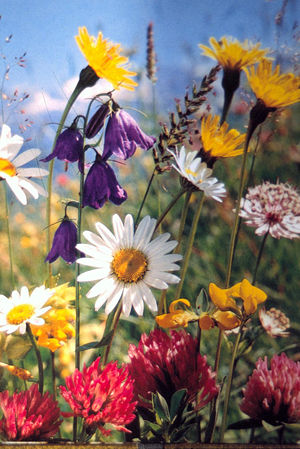Bloom Clock
| Quality resource: this resource is a featured learning resource. |

The Bloom Clock is a research and learning project about flowering plants. The research component is aimed at creating a language for discussing the bloom times of wildflowers and other plants that is neutral in respect to climate, region, and hemisphere, while the learning project aspect is aimed at helping people identify plants using visual keys.
To participate, read the page on How to Contribute, then go to the Contributors page and sign in, and then start adding your records in either of two ways:
- Participants who know plants fairly well (including the scientific names) can log bloom sightings on the current text-based clock or using the Master List.
- Participants can also use the keys, which can help you narrow down and identify plants through simple characteristics and photographic images.
If you want to use the clock to identify a flower you saw today, try using the Keys!
If you are interested in improving the clock or have questions and comments about it, please join us on the Project Discussion page.
What are Bloom Clocks?
[edit | edit source]Bloom clocks are kept by gardeners, ecologists, and others to record the time of year different plants are in bloom.
How are bloom clocks helpful?
[edit | edit source]The data from bloom clocks tell us about both the plants themselves, and the region in which a particular plant is growing.
- Knowing when a plant blooms (relative to other plants) is helpful for garden designers.
- Knowing when nectar-producing plants bloom is useful for farmers, orchardists, and beekeepers who want to ensure a continual supply of nectar.
- Knowing when wind-pollinated plants bloom can help those with allergies (and the doctors that treat them) predict when pollen will be a problem. A major example of this is that in most parts of North America, goldenrods (showy, yellow flowers that don't cause allergies) tend to bloom at the same time as ragweeds (which have green, non-showy flowers, and do cause allergies).
- In Integrated Pest Management (a strategy used by farmers and gardeners in pest and disease control), bloom clocks can provide phenological cues which tell the farmer or gardener when to look out for a certain pest. For example, if a certain pest generally emerges at the same time as a particular plant is blooming, the farmer or gardener will know to check susceptible crops and plants for signs of the pest.
- Patterns in the variation of bloom times with temperature or day length can reveal aspects of plant physiology and growth season relevant to modeling plant response to the environment. Such models help reveal seasonal roles plants play in microclimates and in cycles of nutrients and water.
- Bloom times can be used as indicators for monitoring changes of local and regional climate. Flowers have been blooming earlier in the 21st century, indicating accelerating climate change.[1]
How can the Wikiversity Bloom Clock help support other Wikimedia projects?
[edit | edit source]- When the Bloom Clock project was developed, it was hoped that original research could support other Wikimedia projects. It is possible, but not in this format. See WikiJournal for the accepted approach necessary to support other Wikimedia projects. The following comments represent the goals of this project when it was developed.
- For the Wikipedias and garden books on the Wikibooks, the bloom clock data can eventually yield a "geographically neutral" language for discussing the flowering times of plants, which will be helpful in writing articles.
- For Wikimedia Commons, the visual interface pages can help uploaders identify plants (by using DynamicPageLists for flowers of certain colors and seasons).
How can a bloom clock be created on Wikiversity?
[edit | edit source]If there are enough participants, all it should require is for bloom watchers to note any plants they noticed to be in bloom on a particular day, with information on their location specific enough to determine the local growing degree days and day length, which are the two factors plants respond to. Precipitation reports may also be handy for some climates.
Each report can then be organized to reduce the effects of anomalous data, allowing us to generate geographical "zones" that can eventually be used when describing a plant's expected bloom time in a particular region.
Data can be extrapolated any number of times. Many different species can be used, because they can be correlated to the bloom times of other species over time.
System
[edit | edit source]Hypothesis
[edit | edit source]- Plants may be classified into groups that can accurately predict bloom dates according to geographical zones.
- There will be 2 sorts of zones for most plants: a day-length zone and a growing-degree-day zone (gdd-zone).
- Some plants will not fit into this system.
Plant behaviors
[edit | edit source]- Some plants bloom according to growing degree days.
- Some plants bloom according to day length.
- Some plants bloom according to various conditions.
- The gene Apetala1 controls the processes responsible for blooming based on environmental cues. [2]
Methods
[edit | edit source]- Collect data.
- Collate data.
- Establish zones.
Further testing
[edit | edit source]- Check plant bloom times in areas not previously checked, but in the same zones.
References
[edit | edit source]- ↑ Damian Carrington (2022-02-02). "Flowers arriving a month early in UK as climate heats up". The Guardian. Retrieved 2022-02-02.
- ↑ How Do Flowers Know When to Bloom?

